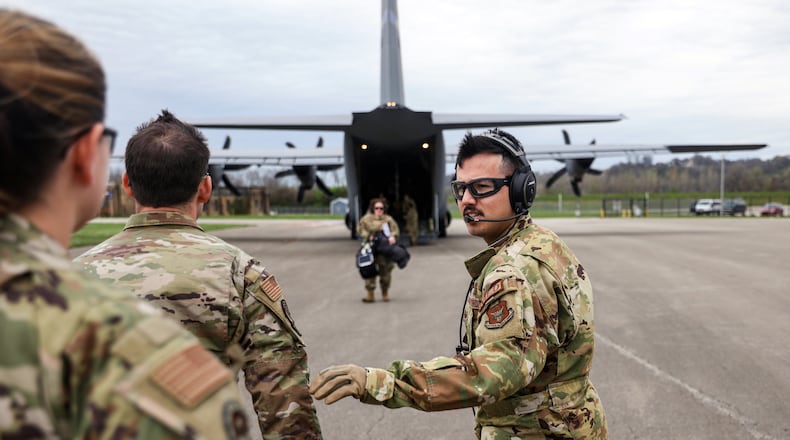Tech. Sgt. Marjorie Butcher, 445th Aeromedical Evacuation Squadron medical technician, said the Wright-Patterson-based crew boarded an Air National Guard C-130J Hercules from the 123rd Airlift Wing and trained through care of six lifelike mannequins on a flight of more than 90 minutes.
Essentially, the C-130 flew in a circle while the medics on board honed their skills.
“We get to experience what those stresses of flights are,” Butcher said in an interview Tuesday.
That’s where continued refinement of skills comes in. These medics have to be able to accommodate everyone from trauma patients to patients simply flying home for physical therapy.
It’s intensive care in the air.
“You can always fall back onto your medical knowledge, that you have the training you’ve experienced,” Butcher said. “But when you’re out there on the aircraft, the mission is always changing. You have to be able to adjust to those changes.”
“The name of the game is to fly ahead of the mission,” said Capt. Nathaniel Copen, squadron director of operations and flight nurse evaluator.
This team must anticipate the needs of the patient in an air evacuation, he said.
Credit: Photojournalist name
Credit: Photojournalist name
It’s the 445th’s hope that this kind of training will continue. More flights are scheduled this summer and additional flights may follow
“This is definitely the start of a new collaboration between C-STARS and our squadron,” Copen said.
The Air Force is the only branch that performs this kind of transport, Butcher said. “We are the patient transport system of the military.”
“It’s a very unique system,” Copen said.
The C-STARS program is essentially a 14-day course at UC that trains between 12 to 15 Air Force medical professionals each course, with 14 classes held annually.
“It’s a lot different taking care of patients on the ground versus up in the air where it’s definitely a lot tighter quarters and limited supplies, and you definitely have to manage your resources very effectively for you to be successful in taking care of these patients,” Capt. Brianne Koessel, 445th flight nurse, said in an account of the exercise shared by the 445th.
Credit: Photojournalist name
Credit: Photojournalist name
Butcher said Air Force medics need to be ready to transport service members from all of its sister branches, contractors, foreign nationals and others.
Copen noted that one of the largest exercises in which the 445th has been involved was responding to needs during the aftermath of Hurricane Katrina in 2005. The wing was involved in air evacuation of civilians from New Orleans at the time.
In fact, at one point, wing members were responding to Kabul, Afghanistan and earthquake relief efforts in Haiti simultaneously, he said.
“What makes air evac so unique is, we don’t deploy as a squadron,” Cohen said. “We don’t go as a whole ... we call up the people as we need them.”
About the Author



